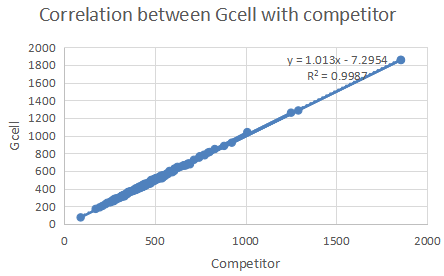Lipoprotein-associated Phospholipase A2
CLINICAL SIGNIFICANCE
SENSITIVITY
PRECISION
a)Repeatability Precision(N=20)
|
|
Mean (U/L) |
CV(%) |
|
Control 1 |
280.515 |
0.66 |
|
Control 2 |
754.955 |
0.52 |
b) Intermediate Precision (N=80)
|
|
Mean (U/L) |
CV(%) |
|
Control 1 |
386.44 |
1.64 |
|
Control 2 |
730.81 |
1.54 |
CORRELATION
The correlation of a well-known brand(x) and Gcell(y) is y = 1.013x-7.2954 R2=0.9987

LINEARITY
The linearity is [50.0, 1200.0] U/L.
INTERFERENCES
|
Bilirubin |
up to 50mg/dL |
|
Hemoglobin |
up to 1000 mg/dL |
|
Ascorbic acid |
up tp 60mg/dL |
|
Intralipid |
up to 2000 mg/dL |
